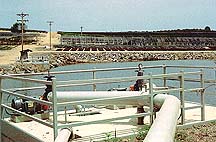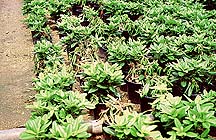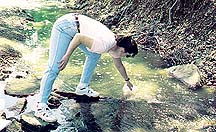Oklahoma Cooperative Extension Service
OSU Extension
Facts
F-1518


Water Quality SeriesCapturing and Recycling
|
| Why Nurseries Capture and Recycle Irrigation Water |
|---|
|
Capture and RecycleConstraints on water availability, environmental initiatives, and increasing regulation have compelled ornamental growers and nurserymen to search for alternative water practices, such as capturing and recycling irrigation runoff. Capture and recycle technology began as a strategy to conserve water and to reduce water and energy costs. A recycling system may also control storm water. The cost of implementing a system depends on various factors such as the volume of runoff to be captured and topographic features that determine the number of retention basins needed to capture runoff. Basically, a capture and recycle system has a network of channels and ditches that capture runoff irrigation water from the nursery beds, and divert it to basins that retain the water. The water can then be pumped from these retention basins back onto production areas or to a storage basin. Wholesale nurseries that irrigate with large volumes of water have large amounts of runoff to capture and recycle.  For retail nurseries and garden centers, a capture and recycle system is designed with this same concept, but on a much smaller scale. To collect irrigation runoff, French drains can be placed in the propagation area, along the lower perimeter of the nursery or garden center, and on the lower side of the nursery stock display area. Instead of large retention basins for holding irrigation runoff, something as simple as a concrete septic tank can be used. Small plastic pipe can be used for moving captured runoff in comparison to the 10- or 12-inch pipe that may be necessary for a larger nursery. In a larger capture and recycle system, retention basins are designed to retain runoff from the nursery and to collect and hold storm water. But, in an urban setting, retail nurseries may choose to divert storm water from off-site so they are not responsible for it. Although no storm water retention limits have been set for Oklahoma, other states require that the first one half to one inch of storm water falling on a nursery site be retained. Most rain events do not overflow the retention basins, but sometimes the discharge limit is exceeded. With careful management of the water levels in retention basins, any discharge will be diluted by off-site storm water. If storm water were not retained, the concentrations of pollutants in the early discharge from the nursery could be very high. Regulations concerning runoff from nurseries and garden centers vary from state to state, so check with local authorities such as the Oklahoma Department of Agriculture for additional information. Benefits of Capture and RecycleIn areas where water is scarce, water may be recycled to conserve water or to reduce water costs. The quantity of water that can be used for irrigation may be limited, or the water may be expensive to pump from deep aquifers. Water can be pumped more cheaply from retention basins at ground level than from deep wells. Recycling has been estimated to conserve 40 to 50 percent of irrigation water in comparison to a system that does not recycle. Quality of the water supply is also a concern. If water quality is poor, flocculation to separate suspended particles or salts from water or acidification to reduce pH to levels acceptable for plant culture may increase the cost of water. Nurseries using overhead irrigation lose a large quantity of this expensive water to runoff. Therefore, it is possible to save money on water costs by recycling, even if the water supply is ample. Another benefit from recycling is a modest decrease in fertilizer costs due to the recycling of nutrients in the irrigation water. Also, with a capture and recycle system, there is more management flexibility in the use of different forms of fertilizers, in scheduling fertilizer applications, and in using certain pesticides in mitigating pest outbreaks. Owners of nurseries situated near lakes or rivers need to maintain a positive public perception of their impact on water quality. One way of accomplishing a friendly working environment with local communities is by removing themselves from the list of potential polluters of that water resource by implementing a capture and recycle system. By making the decision to be proactive in the environment, nursery owners and managers can initiate good working relationships with state officials and help form a workable set of regulations. In comparison to large wholesale nurseries, garden centers and retail nurseries use low volumes of irrigation water and this results in minimal runoff from nursery beds. A capture and recycle system is still beneficial for several reasons. Even a small volume of irrigation runoff with concentrated nutrients can end up in local streams via storm drains. Also, retail nurseries and garden centers can use liners underneath their nursery beds to deter irrigation runoff from infiltrating the soil. This decreases the chance of contaminating ground water sources with the pollutants in runoff irrigation water. In urban locations, nursery and garden center owners may find themselves responsible for the quality of storm water as it flows across and discharges from their property. With a capture and recycle system, channels can be designed to divert storm water around the nursery to avoid mixing with irrigation runoff containing fertilizers, herbicides, and pesticides. Risks of Capture and RecycleRecycling irrigation water has several disadvantages. Building retention basins, waterways, and additional pumping stations to implement a capture and recycle system can be costly. Some of these costs can be offset by decreased water and fertilizer costs. There is also concern about the buildup of salts, herbicides, and pesticides in recycled irrigation water. The solution to these problems can be found with proper management. A high salt content can be solved through dilution with fresh water, while more precise application and thoughtful selection of pesticides and herbicides can reduce the total amount present in the system. Another problem associated with a capture and recycle system is the distribution of weed seeds that pass through sediment screens. The primary disadvantage of the capture and recycle system is the possibility that waterborne pathogens, such as Phytophthora spp., will be recycled back onto crops and result in increased disease problems in the nursery. Phytophthora spp. produce motile zoospores and most species can also produce other types of spores for survival under extreme conditions. The motility of the zoospores allow these fungi to locate infection sites on roots, but passive movement by water can carry them longer distances and is a very important means of spread. These plant pathogens are known to kill or damage a wide variety of economically important plants, including ornamentals.  Diseases caused by these waterborne pathogens should not be a limiting factor for growers. However, to control the Phytophthora populations, their release into runoff, their survival in irrigation water, and the effects of the environment on these processes must be understood. An increase in disease would compel nursery managers to consider decontamination, increasing the cost of recycling substantially. Currently, an acceptable level of pathogens in irrigation water has not been established. This threshold level could vary, depending on nursery management practices and what crops are produced. Studies have shown that although these pathogens are present in high concentrations in runoff water, they may be low at the point of delivery to crops. Many nurseries have been using recycled water for some time now with no apparent increased adverse effects on the crops. Disease Management with Recycling SystemsThe most important ways of managing disease in recycling nurseries are 1) cultivating disease resistant cultivars, 2) scouting for early detection of disease, 3) retaining and diluting captured runoff to reduce or eliminate pathogens, 4) limiting the use of recycled water to only less susceptible plant material, and 5) disinfecting recycled water before reuse on disease sensitive plants. Resistant cultivars should be selected to replace disease susceptible cultivars in production whenever possible. Routine scouting allows for detection of disease before large-scale outbreaks occur. Recycled water should be used only on hardier, established plants. For disease sensitive plant materials or for propagation, only water that has been disinfected or that has been shown to be pathogen free should be used. Plants with similar disease sensitivities should be grouped together to allow for this kind of selective irrigation.  Retention of captured runoff in basins reduces pathogens levels due to natural processes such as settling out and biological and physical degradation. Most pathogen propagules settle to the bottom of retained water, but motile zoospores of Phytophthora spp. congregate near the upper water surfaces. By pumping water between these two zones, the water will be lower for all pathogens including Phytophthora spp. Retaining runoff and diluting it with fresh water may reduce pathogen levels low enough to eliminate the need for disinfection. Retention basins should therefore be designed so they can be diluted with fresh water before reuse and so that captured runoff can be retained as long as possible to allow for settling and degradation of propagules. High levels of Phytophthora could warrant disinfection of recycled water from fast turnover retention basins or sumps. Water can also be filtered before reuse to remove most pathogens. If disinfection of recycled water is deemed necessary, effective methods of disinfection are available, but these are costly and require intense management. It is possible that decontamination will only be warranted in specific locations within the nursery. Water decontamination equipment can be installed and used in these areas only, thereby limiting costs. Common disinfection methods include treatment with chlorine, ozone, and ultraviolet light. The use of chlorine is the least expensive way to control pathogens, although precautions must be used when handling this potentially dangerous chemical. Nursery tailwater can be quite turbid, containing organic and mineral solids, which reduce the effectiveness of water treatments such as chlorination, ozone, and ultraviolet light. These interfering substances must be removed by filtration or other methods before effective disinfection can occur. Flow rate and contact time are crucial elements in the success of these disinfection methods. Clearly, one treatment process is not going to be applicable to every nursery because of differences in water quantity and quality, irrigation demands, and financial resources. |
| Other OSU Publications and Web Sites |
|---|
| Water Quality Handbook for Nurseries (E-951). 1998. Oklahoma Cooperative Extension Service, Division of Agricultural Sciences and Natural Resources, Oklahoma State University. 38 pp. (Available from the OSU University Mailing Services at 405-744-5385). Water Quality Handbook for Nurseries (E-951). 1998. Web version of the above. http://pearl.agcomm.okstate.edu/e951/ Disease Management for Nurseries Using Recycling Irrigation Systems. 1999. Web site authored by Sharon L. von Broembsen, Department of Entomology and Plant Pathology, Oklahoma State University. http://zoospore.okstate.edu/nursery |
SummaryCapture and recycle systems not only protect water resources, but also make good sense from a practical perspective. Water costs are reduced, a constant water supply is assured, storm water is controlled more effectively, and overall management flexibility is enhanced. Although more attention may need to be placed on disease management, this should not be a concern for well managed nurseries. Capturing and recycling irrigation runoff also demonstrates a clear commitment to environmental and water resource protection. F-1518, Capturing and Recycling Irrigation Runoff as a Pollution Prevention Measure (pdf file)
Department of Biosystems and
Agricultural Engineering This publication was originally published 5-99. This page was created 8-99. |